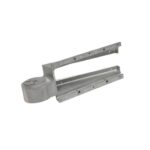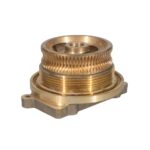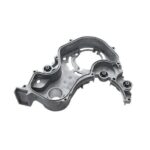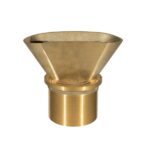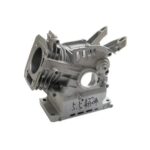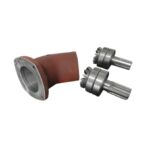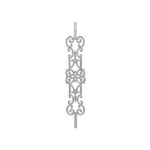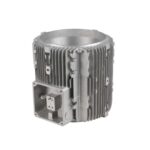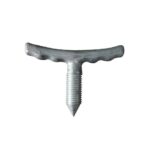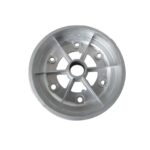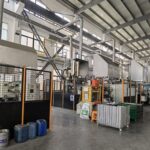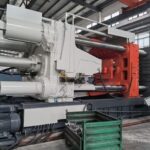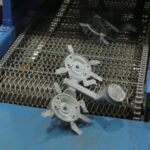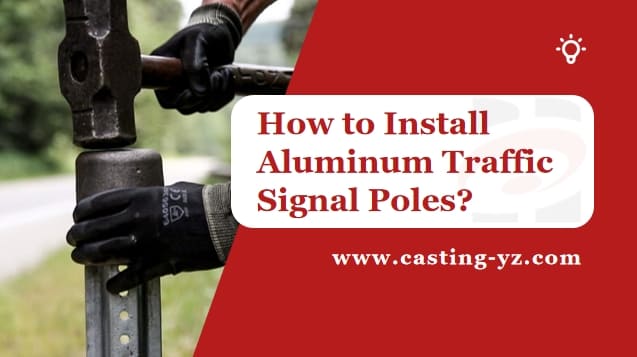
What Are Aluminum Alloy Traffic Signal Poles?
Aluminum alloy traffic signal poles are designed to hold traffic lights, signs, and other road safety equipment.
These poles are constructed from aluminum alloys, offering an ideal balance of durability and lightweight features.
They resist corrosion from environmental factors like rain, wind, and extreme temperatures, making them perfect for outdoor use.
Key Features of Aluminum Alloy Traffic Signal Poles:
- Lightweight: Easier to handle and transport during installation.
- Durability: Resistant to environmental factors, reducing maintenance needs.
- Strength: Designed to withstand high winds and the weight of traffic signals.
What Are the Design Standards for Aluminum Alloy Signal Poles?
The design of aluminum alloy traffic signal poles must comply with various national and international standards to ensure they are safe and durable.
These standards focus on the load-bearing capacity, wind load resistance, and ability to endure extreme weather conditions.
| Design Consideration | Details |
|---|---|
| Load Capacity | The pole must be designed to support the weight of traffic signals, wiring, and additional equipment. |
| Wind Load Resistance | The pole should withstand high winds, typically specified in local building codes (e.g., up to 120 mph in storm-prone areas). |
| Corrosion Resistance | Anodized or powder-coated finishes to prevent rust and deterioration over time. |
| Height and Clearance | Adequate clearance for pedestrian and vehicle safety, often specified in regional traffic codes. |
Standards can vary by country or region, so it’s essential to reference the local traffic and safety regulations when designing the pole.
For instance, in the U.S., the Manual on Uniform Traffic Control Devices (MUTCD) outlines specific requirements for signal pole installation.
What Preparations Are Needed Before Installing Aluminum Alloy Traffic Signal Poles?
Before you begin the installation process, several preparatory steps are necessary to ensure the project is executed correctly and safely.
These include site surveys, ensuring compliance with design standards, material inspections, and securing permits.
1. Site Survey: What Should You Check on Location?
A thorough site survey is the first step in preparing for the installation. Key aspects to assess include:
- Location Assessment: Ensure the selected location is ideal for pole installation, considering factors like traffic flow, visibility of the signal, and distance from roadways.
- Underground Conditions: Investigate if there is a need for underground foundation work. Check if the soil can support the pole’s weight or if additional anchors are required, like concrete foundations or underground fixed stakes.
- Obstacles and Safety: Make sure there are no underground utilities (e.g., water pipes, electrical cables) that could interfere with pole installation. Survey for potential obstacles like trees or buildings that could obstruct the signal’s view.
2. Design Standards: What Traffic and Safety Regulations Must Be Followed?
It’s crucial to adhere to local traffic regulations and safety standards when designing and installing a traffic signal pole. Here are some steps to take:
- Check National and Local Traffic Codes: Consult the national or regional traffic safety regulations to confirm the pole’s design complies with height, clearance, and load requirements.
- Safety Standards: Be sure the pole’s installation adheres to workplace safety laws. In some areas, OSHA (Occupational Safety and Health Administration) standards may apply.
To find the relevant standards, you can consult sources like:
- Local Traffic Authorities: Local road authorities may have specific guidelines for pole installation.
- Online Resources: Websites like the MUTCD (Manual on Uniform Traffic Control Devices) and regional civil engineering codes are excellent references for design standards.
3. Material Inspection: How Do You Ensure Quality Before Installation?
Before installation, a material inspection should be conducted to verify the aluminum alloy pole and associated components are up to standard. This involves:
- Checking the Material Quality: Ensure the aluminum alloy is free from defects like cracks or corrosion.
- Verifying Coatings: Inspect the pole’s protective coatings (e.g., anodization or powder coating) to ensure they meet durability standards.
In addition to the pole itself, check the nuts, bolts, and other components to ensure they’re the correct type and size for the installation.
4. Site Safety: Should the Installation Area Be Secured?
Safety is always a priority. Before beginning installation, take the following steps:
- Traffic Control: Set up proper barriers and signs to redirect traffic and ensure the safety of workers and pedestrians.
- Warning Signs: Place warning signs indicating construction work in progress, and ensure that the installation area is clearly marked with cones or fencing.
- Worksite Preparation: Clear the area of any debris or obstacles, and ensure that all workers wear appropriate protective gear, including helmets and high-visibility jackets.
5. Obtaining Permits: What Legal Approvals Are Needed?
Before beginning the installation process, ensure all required permits and approvals are secured. Depending on the location, you may need:
- Installation Permit: Often required for any roadwork or infrastructure changes.
- Utility Clearance: Ensure you have clearance from utility companies to avoid underground cables or pipes.
- Working Permits for Installation Team: Verify that the installation crew has the necessary work permits and certifications for the job, especially when working on public roads.
What Are the Steps for Installing Aluminum Alloy Traffic Signal Poles?
Once the preparations are complete, the installation can begin. Here are the steps to follow:
- Excavating the Foundation: Depending on the design, dig the foundation for the pole, ensuring it’s deep enough to support the pole and resist wind forces.
- Anchoring the Pole: Place the pole into the foundation and secure it with concrete or anchor bolts.
- Assembling the Signal Components: Attach the traffic signal equipment to the pole, including lights, wiring, and control boxes.
- Testing the System: Before finalizing the installation, conduct tests to ensure the signals work correctly and that the pole is stable.
How Can You Ensure the Quality of the Installation?
After installation, several checks must be performed to ensure everything is in order:
- Stability Check: Verify the pole is properly anchored and does not sway under wind pressure.
- Signal Functionality Test: Ensure the traffic signal operates as expected, with all lights functioning correctly.
- Post-Installation Inspection: Conduct a thorough inspection to ensure compliance with all relevant regulations and safety standards.
What Maintenance Is Required for Aluminum Alloy Traffic Signal Poles?
Regular maintenance is essential to keep the aluminum alloy traffic signal poles in optimal condition. Here are some key maintenance tasks:
- Cleaning the Pole: Remove dirt and debris that may accumulate, especially in urban areas.
- Inspecting the Coatings: Check the protective coatings for wear and tear. If necessary, reapply protective finishes to prevent corrosion.
- Signal System Checks: Ensure the wiring and signal equipment remain functional and replace any malfunctioning parts.
Installing aluminum alloy traffic signal poles involves careful planning, preparation, and adherence to local regulations and safety standards.
By following these steps and ensuring proper installation and maintenance, you can provide reliable and long-lasting support for traffic signals, contributing to road safety and efficient traffic management.
Searching for High-Quality for Cast Aluminum Parts?
You’ve come to the right place! Yongzhu Casting is a certified die casting manufacturer with over 20 years of expertise in the industry.
We have successfully completed numerous die casting projects for Aluminum casting parts, particularly in your industry.

Zhejiang Yongzhu Casting Technology Co., Ltd.
Location: Zhejiang, China
Company type: Manufacturers, Producers, Wholesalers
Year Founded: 2004
Main Products: Aluminium die casting, Mold Making, Die Casting, Sand Casting, Gravity Casting
Leading Chinese producer Yongzhu Casting is formerly known as Hangzhou Higer Metal Products Co., Ltd., was established in 2004.
With 20 years of experience in the industry, we are a specialized manufacturer in Aluminum casting and Machining.
Our products are widely used in various applications such as Automotive, Energy, Lighting, Medical, Home Furnishings, Machinery & Equipment etc. Below are our advantages:
1. Design Review & DFM Support
Our professionals will evaluate your designs and provide suggestions for cost savings. Additionally, we offer Design for Manufacturing (DFM) assistance and conduct mold flow analyses to facilitate efficient production.
2. State-of-the-Art Manufacturing Equipment
Our facility is equipped with advanced hot-chamber and cold-chamber die casting machinery for aluminum and zinc production.
We also utilize high-precision CNC machines in a temperature-controlled workshop, featuring 3-Axis, 4-Axis and 5-Axis setups to manage any project you have.
3. Rigorous Quality Control Measures
Our dedicated quality control team ensures that all parts meet the highest standards of quality and consistency. We employ high-accuracy measurement instruments, including CMM, spectrometers, and X-ray detectors.
4. Comprehensive Surface Treatment Options
We provide a variety of surface finishing techniques for your precision die casting components. Our in-house services include cleaning, polishing, anodizing, shot blasting, and painting.
5. Flexible Project Acceptance
While larger manufacturers often shy away from low-volume projects, and smaller ones may struggle with quality, Yongzhu Casting stands apart. We prioritize customer satisfaction and willingly accept high-mix, low-volume projects like yours.



